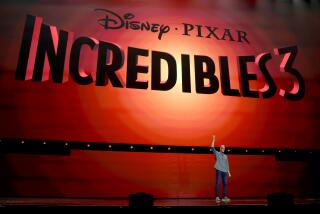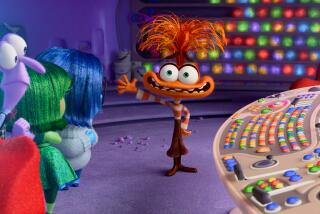‘Dragon’ versus ‘Titans’ versus ‘Alice’ in fight over 3-D screens
Reporting from Los Angeles and Las Vegas — In the wake of the blockbuster “Avatar,” Hollywood’s obsession with 3-D has hit a roadblock.
Paramount Pictures is using high-pressure tactics against theaters to book DreamWorks Animation’s upcoming big-budget 3-D film, “How to Train Your Dragon” onto scarce 3-D screens around the country, according to industry executives. “Dragon,” opening March 26, will be going head to head against the swords-and-sandal 3-D picture “Clash of the Titans,” from Warner Bros., which opens a week later, and Disney’s 3-D “Alice in Wonderland,” still drawing audiences and expected to remain in theaters for several more weeks.
Paramount Pictures is telling theaters that if they don’t show the upcoming DreamWorks-produced “Dragon,” on a 3-D screen, then it will withhold from the theater a 2-D version of the movie to play instead, according to four theater industry executives, who asked not to be identified for fear of reprisal. Many multiplexes only have a single 3-D screen, so not having a conventional version of the highly anticipated DreamWorks family film to play on their other screens would severely affect ticket sales.
“The message is: If you have one 3-D screen available and you don’t play [“Dragon”], they’re not going to give you the version in 2-D,” one California theater operator said. “It’s an underhanded threat.”
Studios are also engaged in the mogul equivalent of hand-to-hand combat over scarce 3-D screens.
Last month DreamWorks Animation SKG Inc.’s Chief Executive Jeffrey Katzenberg, one of Hollywood’s biggest champions of 3-D filmmaking, fired off an e-mail to Barry Meyer, chief executive of Warner Bros., over the studio’s decision to convert “Clash of the Titans” to 3-D from 2-D and open it only a week after “Dragon” was set to debut in theaters.
Disney, meanwhile, is pressing theaters to continue playing “Alice,” which so far has racked up more than $215 million in domestic ticket sales. Warner Bros. is aggressively lobbying them to forego “Dragon” in order to book “Titans” the next week, according to people familiar with the situation. The Warner Bros. picture is on track for a strong opening of about $50 million, according to market surveys.
A Paramount spokeswoman declined to comment about the studio’s efforts to place “How to Train Your Dragon” on 3-D screens.
The jockeying among studios underscores how much is at stake with their costly 3-D bets in the aftermath of “Avatar,” which has sent Hollywood scrambling to stud release schedules with the splashy special-effects films. A 3-D movie adds at least $10 million to the cost of a conventional 2-D production, making it crucial that films land on 3-D screens where studios recapture their investment through higher ticket prices.
The three largest U.S. theater circuits recently secured $660 million in financing that would double the number of digital 3-D screens, but it will be months before the technology is installed, causing an acute shortage. There are about 3,500 3-D screens in the U.S. and Canada, less than 10% of the total. That’s not enough to accommodate two 3-D movies at the same time, let alone three.
The problem is acute for smaller regional theater chains that often have just one 3-D screen in a multiplex, forcing them into a tough decision, potentially alienating a studio upon which they rely for movies.
Nonetheless, with audiences showing a preference to see spectacles like “Avatar” in 3-D and ticket price surcharges boosting revenues, studios are teeing up one 3-D film after another. Nineteen 3-D movies are scheduled in theaters this year, up from 14 in 2009.
The outsized performance of “Alice” has only exacerbated the bottleneck for 3-D screens, since theaters are reluctant to pull it as long as it continues to generate tens of millions in ticket sales in coming weeks.
“This is the most unusual and intense situation that I’ve ever seen,” said Robert Bagby, a 30 year-industry veteran who is president of Missouri-based B&B Theatres, which has 200 screens, only about 40 of which are 3-D. “Of course, it’s a wonderful problem for us that 3-D is doing so well in the market that we’re having these kinds of issues.”
DreamWorks Animation’s Katzenberg has frequently touted the benefits of 3-D to the public and as a boon to his company’s investors. The studio now produces all of his movies in 3-D.
The normally outspoken Hollywood executive, who regularly has a high profile at ShoWest, the theater industry’s annual trade show, wasn’t a presence at this week’s event in Las Vegas where the 3-D conflict was a hot topic of conversation. Instead, he held a private screening of DreamWorks Animation’s May release, “Shrek Forever After,” for overseas theater operators”
Katzenberg set up the screening for the third sequel in the “Shrek” franchise because the screening slot he wanted at the ShoWest convention featured rival Disney/Pixar’s 3-D summer movie, “Toy Story 3,” according to two people familiar with the matter. Katzenberg did not respond to a request for comment and a spokesperson for DreamWorks Animation declined to comment.
A spokeswoman for Paramount denied that a screening slot was sought. She said ShoWest requested to screen “Shrek Forever After,” but the studio declined because that would prevent it from premiering the movie next month at the Tribeca Film Festival in New York
Katzenberg has downplayed the squeeze for 3-D screens and what it means for DreamWorks Animation, which has three 3-D movies this year. He told analysts recently that “we will have more than enough screens to accommodate our audiences in 3-D” for “Dragons.”
One person close to the studio said Paramount was confident that it would book about the same number of 3-D screens to play “Dragon” as Disney secured for “Alice in Wonderland” on its opening weekend: 2,063.
Fights for 3-D screens should die down by next year once exhibitors have added enough screens to handle the supply of movies, said Gerry Lopez, chief executive of AMC Entertainment, one of the nation’s largest theater chains. In the meantime, he said, both sides should try to work together.
“We’ve got people out there threatening theater operators,” Lopez said. “It’s a dangerous game . . . . I don’t think this is part of a productive solution.”
richard.verrier
@latimes.com
More to Read
The biggest entertainment stories
Get our big stories about Hollywood, film, television, music, arts, culture and more right in your inbox as soon as they publish.
You may occasionally receive promotional content from the Los Angeles Times.











